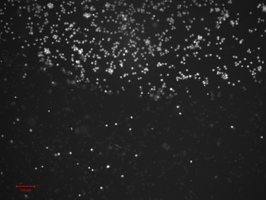Journal of
eISSN: 2572-8466


Short Communication Volume 10 Issue 1
B.I. Stepanov Institute of Physics of NAS Belarus, Belarus
Correspondence: V Lapina, B.I. Stepanov Institute of Physics of NAS Belarus,68 Nezavisimosti Ave., 220072, Minsk, Belarus
Received: January 05, 2023 | Published: January 16, 2023
Citation: Lapina V, Pavich T, Bushuk S, et al. New bioengineering approaches for immunotherapy. J Appl Biotechnol Bioeng. 2023;10(1):14-15. DOI: 10.15406/jabb.2023.10.00321
New approaches for immunotherapy based on nanodiamond particles have been developed. The possible ways of conjugate synthesis comprising antibody as targeting vector, nanodiamond particles as carrier, chlorine e6 as photosensitizer, have been demonstrated. Spectral-luminescent properties of the conjugates have been studied. It has been shown that the conjugate obtained effectively binds to cells in vitro. It was observed that chlorine e6 immobilized on ND particles reveals its photodynamic activity under illumination and induces death of cells. Based on obtained results, possible advanced therapeutic strategies for novel medicine technologies have been proposed.
Keywords: antibody, chlorine e6, immunotherapy, nanodiamond particle, photosensitizers
Fast development of nanotechnologies has opened wide perspectives in various areas of science and technology owing to the introduction of novel materials and composites possessing unique properties. Among them of special significance are carbon nanomaterials which attract unceasing interest of researchers and present growing manifold of studies and practical applications. The use of nanoparticles has led to the breakthrough in new generation drugs design due to the reasonable combination of their physical-chemical properties, such as nano-dimension, surface chemistry, functionalization facility, etc. and the biological properties of drug-constituting components. Various nanomaterials are known to be employed in biologically active substances synthesis.1 Well-grounded data witness that general efficiency of nanodrugs significantly exceeds that of non-conjugated active compounds present in their structure. We proposed a number of novel bio-engineering approaches to the synthesis of selective photodynamic anti-cancer drugs.2 A synthesis scheme was developed for nanoconjugates containing carbon nanoparticles as a carrier platform, photosensitizer (chlorine e6) as an active agent and folic acid representing targeting vector. It has been shown that conjugate-bound photosensitizer has enhanced photodynamic activity. The complex has been found to be variably stable with respect to autosensitized photodestruction depending on the type of chlorine e6 conjugation with carbon nanoparticles.3,4
The current paper is related to immunotherapy prospects of novel nanoconjugate drug. The conjugate is proposed consisting of photodynamically active drug and antibody immobilized directly on diamond nanoparticles (and/or their aggregates) or connected by means of special linker with diamond nanoparticles (ND) and with their aggregates. Antibody in a content of a conjugate can be connected with a specific antigen expressed on tumor cells. The conjugate is capable of interacting with cells-targets and leads to their destruction under optical excitation. The method is also proposed of obtaining this conjugate by the conjugation of nanodiamond particles (and/or their aggregates) to photodynamically active agents directly or using a linker, and then to antibodies. The synthesis was performed using mouse homogeneous antibodies of АТ 6-11В-1 at ~1 mg/ml concentration and molecular weight of 50 kDa (Sigma-Aldrich), chlorine е6 (Minsk plant of medical drugs), 1,1′-carbonyldiimidazole (Sigma-Aldrich), sulfinylchloride (Sigma-Aldrich), diaminopyridine (DMAP) (Sigma-Aldrich), 0.1 M phosphate buffer with рН of 7.4, polyethyleneglycol (PEG) (Sigma-Aldrich) and tetrahydrofuran (THF) (Sigma-Aldrich), dimethyl sulfoxide (DMSO).
The technique of conjugation of antibody with ND is based on the reaction, which is both efficient and selective, namely, the reaction between activated carboxyl groups of nanodiamonds and aminogroups of antibodies, resulting in amide bond formation. Chlorine е6 was conjugated with nanodiamonds by the interaction of aminogroups on the basis of ND with activated carboxyl groups of chlorine е6, in the result of which amide bond is formed too. The synthesis of Chlе6-ND-АТ complex was conducted in three stages: 1) activation of nanodiamond carboxyl group by tionylchloride; 2) activation of chlorine е6 carboxyl group and its interaction with free amimogropus of ND; 3) connection of antibody to ND-Chl е6 complex to activated ND carboxyl groups. In order to confirm the interaction of the nanocomplex with living cells laser scanning microscopy of nanocomplex-containing suspension of green monkey kidney cells has been performed (Figure 1). Intracellular chlorine e6 distribution was registered based on its fluorescence under 488 nm excitation.

Figure 1 Confocal image of intracellular distribution of Ab-NВ-Chle6 complex in living green monkey kidney cells.
The presence of the conjugate in the cells has been further proved by microspectroscopy measurements by means of confocal laser scanning microscope (Figure 2) where clear chlorine e6 spectrum was detected originating from cell interior. This demonstrates the interaction of the conjugate with cells and yields grounds to expect its photodynamic activity.
The photodynamic effect of the conjugate proposed is depicted in Figure 3. Based on propidium iodide fluorescence, the difference of cells state is shown in irradiated (upper part of Figure 3) and non-irradiated areas of nanoconjugate treated cells suspension. As it can be seen, the irradiation has led to massive cases of cell death proving enhanced photosensitizing activity of the nanoconjugate.

Figure 3 Photodynamic activity of Chl.e6-ND-Ab conjugate Irradiation border in the sample (PI fluorescence).
Based on obtained results, possible advanced therapeutic strategies for novel medicine technologies have been proposed.
None.
There are no conflicting interests declared by the authors.

©2023 Lapina, et al. This is an open access article distributed under the terms of the, which permits unrestricted use, distribution, and build upon your work non-commercially.